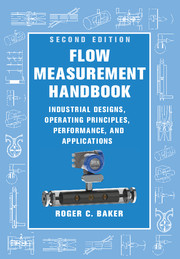Book contents
- Frontmatter
- Dedication
- Contents
- Preface
- Acknowledgements
- Nomenclature
- 1 Introduction
- 2 Fluid Mechanics Essentials
- 3 Specification, Selection and Audit
- 4 Calibration
- 5 Orifice Plate Meters
- 6 Venturi Meter and Standard Nozzles
- 7 Critical Flow Venturi Nozzle
- 8 Other Momentum-Sensing Meters
- 9 Positive Displacement Flowmeters
- 10 Turbine and Related Flowmeters
- 11 Vortex Shedding, Swirl and Fluidic Flowmeters
- 12 Electromagnetic Flowmeters
- 13 Magnetic Resonance Flowmeters
- 14 Ultrasonic Flowmeters
- 15 Acoustic and Sonar Flowmeters
- 16 Mass Flow Measurement Using Multiple Sensors for Single-Phase Flows
- 17 Multiphase Flowmeters 508
- 18 Thermal Flowmeters
- 19 Angular Momentum Devices
- 20 Coriolis Flowmeters
- 21 Probes for Local Velocity Measurement in Liquids and Gases
- 22 Verification and In Situ Methods for Checking Calibration
- 23 Remote Data Access Systems
- 24 Final Considerations
- References
- Main Index
- Flowmeter Index
- Flowmeter Application Index
13 - Magnetic Resonance Flowmeters
Published online by Cambridge University Press: 05 August 2016
- Frontmatter
- Dedication
- Contents
- Preface
- Acknowledgements
- Nomenclature
- 1 Introduction
- 2 Fluid Mechanics Essentials
- 3 Specification, Selection and Audit
- 4 Calibration
- 5 Orifice Plate Meters
- 6 Venturi Meter and Standard Nozzles
- 7 Critical Flow Venturi Nozzle
- 8 Other Momentum-Sensing Meters
- 9 Positive Displacement Flowmeters
- 10 Turbine and Related Flowmeters
- 11 Vortex Shedding, Swirl and Fluidic Flowmeters
- 12 Electromagnetic Flowmeters
- 13 Magnetic Resonance Flowmeters
- 14 Ultrasonic Flowmeters
- 15 Acoustic and Sonar Flowmeters
- 16 Mass Flow Measurement Using Multiple Sensors for Single-Phase Flows
- 17 Multiphase Flowmeters 508
- 18 Thermal Flowmeters
- 19 Angular Momentum Devices
- 20 Coriolis Flowmeters
- 21 Probes for Local Velocity Measurement in Liquids and Gases
- 22 Verification and In Situ Methods for Checking Calibration
- 23 Remote Data Access Systems
- 24 Final Considerations
- References
- Main Index
- Flowmeter Index
- Flowmeter Application Index
Summary
Introduction and Some Early References
In the first edition of this handbook, I mentioned that flowmeters depending on magnetic resonance (MR) had been suggested, but that I was not aware of an instrument on the market. Nuclear magnetic resonance (NMR now, apparently preferably referred to as MR) essentially marks the fluid and measures transit times (Genthe 1974; King and Rollwitz 1983). Gol'dgammer, Terent'ev and Zalaliev (1990) showed that the magnetic resonance signal amplitude of a gas-liquid mixture in diamagnetic fluids depended on the liquid content regardless of the physicochemical properties of the medium and conditions of flow. This linearity was destroyed if paramagnetic centres were added to the fluid. De Jager, Hemminga and Sonneveld (1978) described their experimental data from water flow velocity measurements in the range of 0.5 to 5 mm/s by means of nuclear magnetic resonance using a sequence of inhomogeneous 180° pulses and a gradient in the stationary magnetic field. MR had been used in liquid-gas flows to measure the mean velocity of the liquid averaged over the liquid volume and also the average of the liquid fraction (Kruger, Birke and Weiss 1996). The combination provided the mass flow of the liquid. In tests using water as the liquid, the authors claimed to determine the mass flow to within ±5%.
Scott (1982), in “Developments in Flow Measurement–1”, comments that “Sensing of the flow relies on the application initially of a magnetic field to the nuclei of hydrogen or fluorine in the flow and the subsequent (downstream) removal of this influence. The nuclei enter the magnetic section with their individual magnetic orientations completely random and leave with their nuclear orientations aligned in the direction of the magnetic field. In the detector section which follows they approach a tagger coil and then a receiver coil. The former injects a short high intensity burst of radio frequency waves into the meter. This demagnetises a ‘window’ in the magnetised fluid and the window is discerned by the detector coil as a momentary drop in output signal. A knowledge of the distance between the tagger and the receiver, coupled with a time-of-flight measurement between them leads to the mean flow velocity.” The reader is referred to Scott's book for early references to this technique.
- Type
- Chapter
- Information
- Flow Measurement HandbookIndustrial Designs, Operating Principles, Performance, and Applications, pp. 408 - 418Publisher: Cambridge University PressPrint publication year: 2016



